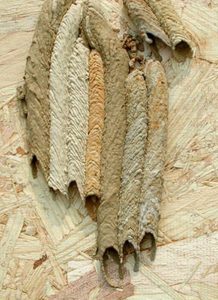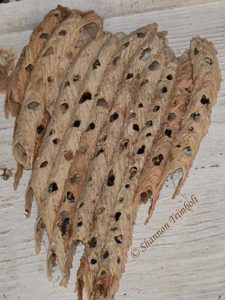Carolina wrens, woodpeckers, and many of our familiar backyard birds are insect eaters. As you might imagine, insects and other bugs become much more difficult to find during the winter. In natural areas, some of the places that they may forage for bugs over the winter include under tree bark, in the leaf litter, and in goldenrod galls or similar galls on other plants. Around our homes and yards; however, there is another common foraging option – mud dauber nests.

Mud dauber is the common name for several different families of wasps that build their nests out of mud. (Some people call them dirt daubers, instead of mud daubers.) Mud dauber nests are typically built in a protected area. In the wild, this could mean under a rock ledge, in a tree cavity, or in another somewhat protected area. Around our homes, this often means under eaves, under the roof of a covered porch, in crawl spaces, or under a deck. The shape of the mud dauber nest can vary depending on the species of wasp.
Each mud dauber nest will contain multiple eggs, each in its own individual cell. After the eggs hatch, the larva feed on spiders that the female wasp put in each cell. The adult wasps die off by late fall or early winter, but their young will overwinter in the nests as either a larva or pupa. The larva or pupa can be a highly nutritious and protein-rich food source for birds during the winter.
Carolina wrens and downy woodpeckers are among the birds that will quickly prey upon any mud dauber nests that they find in the winter. This is true both in natural areas and around our homes, but it is much easier to observe around our homes. Once a Carolina wren or downy woodpecker finds a mud dauber nest, it will peck a hole in the mud casing, pull out the larva or pupa, eat it, and repeat the process for each cell in the nest.
Living in the country, mud daubers often build their nests under the roof of our porches. I used to hate it. Mud daubers tend to be docile and will only sting if heavily provoked, but I still didn’t like the idea of having wasps on the porch. It didn’t matter if the nests were high enough up that I didn’t have to worry about the wasps posing any threat what-so-ever. I still didn’t like having them there. However, I don’t mind them anymore. Now, I look at them as natural bird feeders.

All winter long, the Carolina wrens and downy woodpeckers are hopping around our porches and checking out the mud dauber nests. I enjoy watching them as they go from one nest to the next, checking each one to make sure that it is empty and cracking into any cells that may still have a larva or pupa. I think they’ve killed off every mud dauber nest that has been built on our porches since I started leaving the nests for the birds.
Obviously, if the nest is being built in an area that poses a potential safety hazard (like right next to the door) then I get rid of it early on. However, if it isn’t a safety threat, then I’ve learned to let the birds take care of the mud dauber nests in the winter when they can get a tasty and nutritious treat for their efforts.
Not everyone is going to be able to leave the mud dauber nests for the birds, but it might be worth considering at least in some locations around your property. Even if you decide that this isn’t something you can do, it’s nice to know that the birds are likely to eliminate some of the mud dauber nests that you miss.

Backyard Ecology: Exploring Nature in Your Backyard
Nature isn’t just “out there.” It’s all around us, including right outside our doors. Hi, my name is Shannon Trimboli, and I am the host of Backyard Ecology. I live in southcentral Kentucky and am a wildlife biologist, educator, author, beekeeper, and owner of a nursery specializing in plants for pollinators and wildlife conservation. I invite you to join me as we ignite our curiosity and natural wonder, explore our yards and communities, and improve our local pollinator and wildlife habitat. Learn more or subscribe to my email list at www.backyardecology.net.

Leave a Reply